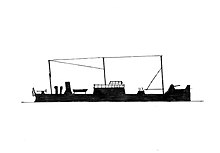HMS Kruger
HMS Kruger (ex Russian President Kruger , Cyrillic Президент Крюгер, named after Paul Kruger ) was an auxiliary cruiser of the Royal Navy in World War I and the Russian Civil War and was the flagship of the British Caspian Flotilla from 1918-1919 .
Technical specifications
Apart from the size (approx. 1000 t), no technical data has been handed over to the ship. Presumably it was a relatively new vehicle, as it was selected as the flagship by Commodore David Thomas Norris (1875-1937). The former President Kruger had been used as a freighter on the Caspian Sea and had facilities for some passengers. Presumably she usually served in the liner service between Astrakhan - Petrovsk (today Makhachkala ) - Baku . In an emergency, the Kruger could take up to 800 soldiers. Like all steamers on the Caspian Sea, it was operated with masut , a by-product of oil production ; The home port was apparently Baku.
Use in World War I and Russian Civil War
Presumably in August 1918 she was put into service as a flagship by the advance unit of the British Caspian Flotilla in Baku and equipped with four or five guns . The crew and the captain of the ship remained Russian, while the officers were members of the Royal Navy or Royal Navy Reserve. Until March 1919, the "Kruger" was still flying the Russian war flag, but with a British command flag . In March the whole flotilla was formally taken over by the Royal Navy and the White Ensign was hoisted on all units . In the spring / summer of 1919 the Kruger got into fights several times with units of the Red Russian Kaspi flotilla . In the naval battle of Fort Alexandrowsk she was hit hard and got out of control for a short time due to damage to the engine and control system.
At the end of August 1919 she was handed over as the last ship in the flotilla of Denikin's Belarusian volunteer army . Presumably, like the rest of the former British flotilla, she fled to the Persian port of Bandar Anzali in April 1920 so as not to fall into the hands of the insurgent Bolsheviks in Baku. Apparently, after the coup on Enseli on May 18, 1920 , she was captured by the Kaspi flotilla under Fyodor Fyodorovich Raskolnikov like all other ships and returned to Baku. Presumably from this point on she was used again as a merchant ship, but possibly no longer under her old name President Krüger .
literature
- German Society for Shipping and Naval History (ed.): Patrick Thornhill. From Scapa Flow to the Caspian Sea. An uncensored diary 1918–1919 . Edited by Cord Eberspächer and Gerhard Wiechmann. Translator Dirk Nottelmann, Bremen (Hauschild) 2011. ISBN 978-3-89757-498-4
- Werner Zürrer: Caucasus 1918–1921. The struggle of the great powers over the land bridge between the Black Sea and the Caspian Sea , Düsseldorf 1978.
- David Norris: Caspian Naval expedition, 1918-1919 , in: Journal of the Royal Central Asian Society , Vol. 10, Issue 3, 1923, pp. 216-240.
- Paul Halpern (ed.): The Mediterranean Fleet, 1919-1929. Publications of the Navy Records Society Vol. 158 , Farnham, Surrey (Ashgate) 2011. ISBN 9781409427568
